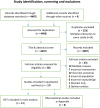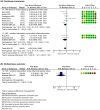Audit and feedback to change diagnostic image ordering practices: A systematic review and meta-analysis
- PMID: 38837994
- PMCID: PMC11152319
- DOI: 10.1371/journal.pone.0300001
Audit and feedback to change diagnostic image ordering practices: A systematic review and meta-analysis
Abstract
Background: Up to 30% of diagnostic imaging (DI) tests may be unnecessary, leading to increased healthcare costs and the possibility of patient harm. The primary objective of this systematic review was to assess the effect of audit and feedback (AF) interventions directed at healthcare providers on reducing image ordering. The secondary objective was to examine the effect of AF on the appropriateness of DI ordering.
Methods: Studies were identified using MEDLINE, EMBASE, CINAHL, Cochrane Central Register of Controlled Trials and ClinicalTrials.gov registry on December 22nd, 2022. Studies were included if they were randomized control trials (RCTs), targeted healthcare professionals, and studied AF as the sole intervention or as the core component of a multi-faceted intervention. Risk of bias for each study was evaluated using the Cochrane risk of bias tool. Meta-analyses were completed using RevMan software and results were displayed in forest plots.
Results: Eleven RCTs enrolling 4311 clinicians or practices were included. AF interventions resulted in 1.5 fewer image test orders per 1000 patients seen than control interventions (95% confidence interval (CI) for the difference -2.6 to -0.4, p-value = 0.009). The effect of AF on appropriateness was not statistically significant, with a 3.2% (95% CI -1.5 to 7.7%, p-value = 0.18) greater likelihood of test orders being considered appropriate with AF vs control interventions. The strength of evidence was rated as moderate for the primary objective but was very low for the appropriateness outcome because of risk of bias, inconsistency in findings, indirectness, and imprecision.
Conclusion: AF interventions are associated with a modest reduction in total DI ordering with moderate certainty, suggesting some benefit of AF. Individual studies document effects of AF on image order appropriateness ranging from a non-significant trend toward worsening to a highly significant improvement, but the weighted average effect size from the meta-analysis is not statistically significant with very low certainty.
Copyright: © 2024 Badejo et al. This is an open access article distributed under the terms of the Creative Commons Attribution License, which permits unrestricted use, distribution, and reproduction in any medium, provided the original author and source are credited.
Conflict of interest statement
No authors have competing interests.
Figures



Similar articles
-
The future of Cochrane Neonatal.Early Hum Dev. 2020 Nov;150:105191. doi: 10.1016/j.earlhumdev.2020.105191. Epub 2020 Sep 12. Early Hum Dev. 2020. PMID: 33036834
-
Strategies to improve the implementation of healthy eating, physical activity and obesity prevention policies, practices or programmes within childcare services.Cochrane Database Syst Rev. 2020 Feb 10;2(2):CD011779. doi: 10.1002/14651858.CD011779.pub3. Cochrane Database Syst Rev. 2020. PMID: 32036618 Free PMC article.
-
Alcoholics Anonymous and other 12-step programs for alcohol use disorder.Cochrane Database Syst Rev. 2020 Mar 11;3(3):CD012880. doi: 10.1002/14651858.CD012880.pub2. Cochrane Database Syst Rev. 2020. PMID: 32159228 Free PMC article.
-
Printed educational materials: effects on professional practice and healthcare outcomes.Cochrane Database Syst Rev. 2020 Jul 31;8(8):CD004398. doi: 10.1002/14651858.CD004398.pub4. Cochrane Database Syst Rev. 2020. PMID: 32748975 Free PMC article.
-
Manually-generated reminders delivered on paper: effects on professional practice and patient outcomes.Cochrane Database Syst Rev. 2019 Dec 18;12(12):CD001174. doi: 10.1002/14651858.CD001174.pub4. Cochrane Database Syst Rev. 2019. PMID: 31858588 Free PMC article.
References
-
- Canadian Institute for Health Information. Unnecessary Care in Canada. Ottawa, ON: CIHI; 2017.
Publication types
MeSH terms
LinkOut - more resources
Full Text Sources
Medical

